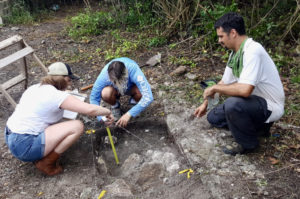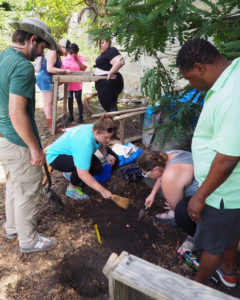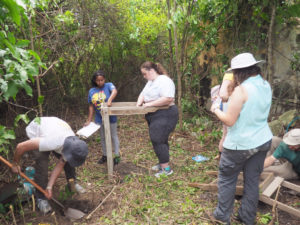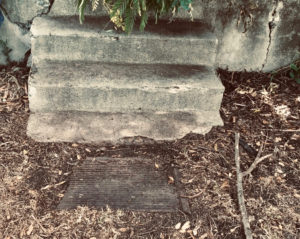
“Those who once upon a time were invisible, we make them visible.” – Garrey Dennie, historian

foundation in an excavation as Steve Lenik looks on. (Photo by Steve Lenik)
During a study tour that began in July on St. Croix, archaeologist Steve Lenik, historian Garrey Dennie and nine students from St. Mary’s College in Maryland unearthed findings of the enslaved families who lived in the long row houses at Estate Bethlehem.
The first study tour of Estate Bethlehem in 2017 revealed very dense deposits of food remains, along with ceramics, pottery and glass bottles from the years 1750 to 1825. The findings provide a window into the nature of the daily lives of the enslaved Africans in both the 18th and 19th centuries.
Lenik conducted archaeological digs in 2002 at Estate Bethlehem Old Works, the sugar plantation, recording a cemetery of enslaved Africans and a laborer village that existed from the early 1800s.
The tour this year, said Lenik, focuses on the long row houses.
“It appears that most of these row houses are structures in many places on St. Croix and most of the Caribbean that was built from 1790 to 1830 and up to 1840 as the slave trade was ending,” Lenik said. “I believe these were built in the 19th century, based on the ceramics, and occupied until they closed the factory in 1966. So that’s the second phase of housing. The factory closed for a time in the 1930s during the Depression.”
Lenik also said he believes many of the cinder block houses and detached kitchens are probably from the mid-20th century.
“In one place, you have the experience of a laborer or a more specialized person – a sugar boiler,” Lenik said. “In archaeology, we are looking at what happened in the front yard – the side yard – in the rear. We have oral histories we’re doing as well, even insights from Professor Garrey.”
Dennie said he took advantage of his Caribbean roots.
“I grew up the first 20 years of my life on St. Vincent in a ‘tenement yard.’ When I see these houses, I realize the similarity where people are living in these long houses back to back, sometimes facing each other. Washing and cooking is done, and children are playing in the long, open space between the houses,” Dennie said.

(Photo by Steve Lenik)
“And you see that showing up in music, ‘Tenement Yard’ and ‘Barracks Yard’ in the Caribbean that slaves and descendants of slaves have had to live in these kinds of conditions,” Lenik said.
“There are five, maybe six extended families living in close quarters in these houses. Where are they throwing their garbage away? Where are they keeping a garden? Where are they washing their clothes? The interviews can tell us that.”
Charcoal found in this area means that people might be roasting a breadfruit or boiling a pot of water. The front yard has a street going past it. It’s a public area.
A small, rectangular space could be an area where children played.
“We found a marble,” Dennie recalled. “Caribbean children play marbles. We know that.”
“I’ve lived as a Caribbean man all my life, and it helps me to have a connection to what I’m seeing here. Having grown up in a ‘tenement yard,’ I can relate. What is valuable about this yard, and all other yards, is that they contain human lives, and human life is valuable.”
“And so these are stories, which are often not told,” Dennie said. “It allows us to tell their stories and give value to their lives. Their lives had meaning.”
Dennie said the key is reverence.

artifacts. (Photo by Steve Lenik)
“We treat our past with reverence. Those who once upon a time were invisible, we make them visible,” Dennie said.
Undergraduate students at St. Mary’s College who are helping in this revelation come from a wide range of disciplines, with majors ranging from physics, economics, chemistry, computer science and other fields, but all are connected to archaeology.
Gunther Prevost will return to St. Mary’s College for his senior year, and through his study of economics, he can understand the dynamics of the sugar plantation and the process of using the sugar and turning it into rum. He has learned that the Danes refined the sugar and sold it to other European countries from the work on the backs of the enslaved people.
Lenik said the group is also trying to document other houses on this trip.
“Is this an anomaly? Are they all like this? What happens when you go off Centerline Road on the other side by the University of the Virgin Islands. There’s also one behind Whim Plantation Museum,” he said.
“Dotted throughout the landscape of St. Croix, you have the new houses, but you also have these,” Lenik noted.
He describes them as windows to the past.
“People have to eat, they have to sleep, to bathe. They have to communicate and go to work. The living space reflects all of that,” Dennie observed.
Comparing the living spaces the slaves inhabited 200 years ago to the living spaces we inhabit now allows you to see fundamental changes that have occurred in Crucian life, Dennie said.
“Of course, the archaeology objects we’re finding here help, but there’s so much more to be learned.” As we’re talking to people,” Lenik noted, “we realize some people are still living here.”
“Not everything that happens here leaves a material record. It’s the meaning that’s attached to the space and so much more ephemeral activities that wouldn’t leave a mark.”

Emily Geckle will return to Maryland as a sophomore in anthropology with a focus on archaeology.
“It’s been rewarding to see a new culture and experience a lot of history,” she said. “We found out that a lot of the older generation was not taught the history of slavery, and that’s what our professor is bringing to them. And they like what he is doing in the preservation of their history.”
“We found roofing nails. The roofs were torn off the building so people would not live in them,” Lenik observed. In the end, the place was abandoned.
When Hess Oil Corporation and Martin Marietta opened up employment, bonded workers from other islands accounted for an inter-island migration. They occupied these buildings and some of the newer cinder block buildings. Some of the workers are still here, and some of their children are still here.
Dennie said in the sub-discipline of the Archaeology of Slavery, the lives of slaves were essential to the archaeology mission. He believes that you can’t understand plantation slavery without understanding the world the masters made, and you must also look at the world the slaves made.
Lenik looks forward to another archaeological tour in 2021. There is a possibility that he might return solo in 2020.





